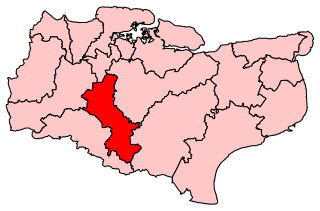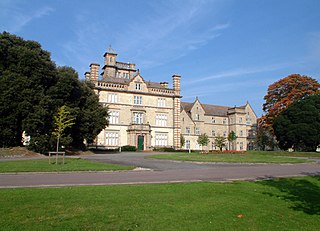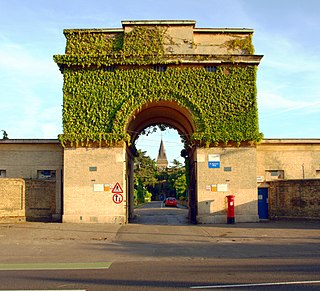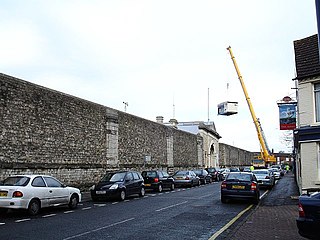
Psychiatric hospitals, also known as mental health hospitals, or behavioral health hospitals are hospitals or wards specializing in the treatment of severe mental disorders, including schizophrenia, bipolar disorder, eating disorders, dissociative identity disorder, major depressive disorder, and others.

Maidstone is the largest town in Kent, England, of which it is the county town. Maidstone is historically important and lies 32 miles (51 km) east-south-east of London. The River Medway runs through the centre of the town, linking it with Rochester and the Thames Estuary. Historically, the river carried much of the town's trade as the centre of the agricultural county of Kent, which is known as the Garden of England. There is evidence of settlement in the area dating back before the Stone Age. The town, part of the borough of Maidstone, had an approximate population of 100,000 in 2019. Since World War II, the town's economy has shifted from heavy industry towards light industry and services.

Bracebridge Heath is a village and civil parish in the North Kesteven district of Lincolnshire, England. It is 2 miles (3 km) south of Lincoln and straddles the border with the Lincoln and North Kesteven district boundaries.

Maidstone and The Weald is a constituency in Kent represented in the House of Commons of the UK Parliament since 2010 by Helen Grant of the Conservative Party. She succeeded fellow party member Ann Widdecombe, who had held the seat since it was created for the 1997 general election.

Barming is a civil parish in the Maidstone District of Kent, England. It lies to the west of Maidstone and at the 2011 census had a population of 2,690. The eastern end of the parish is part of the built-up area of Maidstone, although the remainder is much more rural. The River Medway forms its southern boundary.

Fulbourn Hospital is a mental health facility located between the Cambridgeshire village of Fulbourn and the Cambridge city boundary at Cherry Hinton, about 5 miles (8 km) south-east of the city centre. It is managed by the Cambridgeshire and Peterborough NHS Foundation Trust. The Ida Darwin Hospital site is situated behind Fulbourn Hospital. It is run and managed by the same trust, with both hospitals sharing the same facilities and staff pool.

St Bernard's Hospital, also known as Hanwell Insane Asylum and the Hanwell Pauper and Lunatic Asylum, was an asylum built for the pauper insane, opening as the First Middlesex County Asylum in 1831. Some of the original buildings are now part of the headquarters for the West London Mental Health NHS Trust (WLMHT).

HM Prison Maidstone is a Category C men's prison, located in Maidstone, Kent, England and operated by His Majesty's Prison Service.

Tovil is a civil parish in the Borough of Maidstone, in Kent in the South East of England. It is a mixture of residential and industrial zoning, with an increase in commercial usage towards the centre of Maidstone, and more arable use on the outskirts.
Barming Heath is an area of north-western Maidstone in Kent, England. Its parish church is dedicated to St Andrew.

Stone House Hospital was a hospital and former mental illness treatment facility in Stone, near Dartford, Kent, in the United Kingdom.

Kew Lunatic Asylum is a decommissioned psychiatric hospital located between Princess Street and Yarra Boulevard in Kew, a suburb of Melbourne, Australia. Operational from 1871 to 1988, Kew was one of the largest asylums ever built in Australia. Later known as Willsmere, the complex of buildings were constructed between 1864 and 1872 to the design of architects G.W. Vivian and Frederick Kawerau of the Victorian Public Works Office to house the growing number of "lunatics", "inebriates", and "idiots" in the Colony of Victoria.
John Whichcord Sr. (1790–1860) was a British architect who worked in Maidstone, Kent and designed many public and institutional buildings in the town.

Maidstone Hospital is a hospital in Barming, Maidstone, England. It is managed by the Maidstone and Tunbridge Wells NHS Trust.

St Augustine's Hospital was a psychiatric hospital in Chartham, Kent, England. It was founded as the second, or East, Kent County Asylum in 1872. In 1948 the hospital became part of the National Health Service and was renamed St Augustine's Hospital. The hospital gained notoriety in the 1970s when it was the subject of a committee of inquiry into malpractice and mismanagement. St Augustine's Hospital closed in 1993 and the site is now occupied by housing, although a few of the original hospital buildings remain.

John Whichcord, Jr. was an English architect, who designed several office buildings in London and, also, the Grand Hotel in Brighton.

St. Brendan's Hospital was a psychiatric facility located in the north Dublin suburb of Grangegorman. It formed part of the mental health services of Dublin North East with its catchment area being North West Dublin. It is now the site of a modern mental health facility known as the "Phoenix Care Centre". Since the official opening of the Richmond Lunatic Asylum in 1815 the Grangegorman site has continuously provided institutional facilities for the reception of the mentally ill until the present day. As such the Phoenix Care Centre represents the continuation of the oldest public psychiatric facility in Ireland.

Tunbridge Wells Hospital is a large district general hospital in Pembury near Royal Tunbridge Wells, Kent, England, run by the Maidstone and Tunbridge Wells NHS Trust. The hospital is located on Tonbridge Road, around 0.5 kilometres (0.31 mi) to the north-west of Pembury, close to the A21 trunk road. It is surrounded by woodland on three sides.

Edward Parker Charlesworth (1783–1853) was an English physician, known as an innovator in psychiatric treatment.

Bexley Hospital was a psychiatric hospital at Old Bexley Lane, Dartford Heath, Bexley, in the County of Kent. It operated between 19 September 1898 and 2001.

























